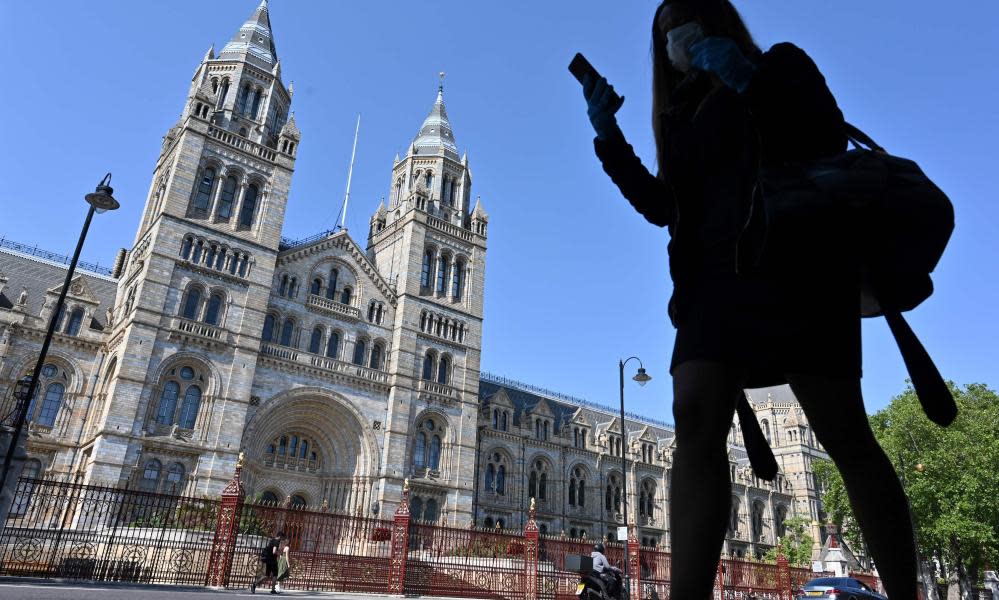Big three London museums to reopen in August

The V&A, the Science Museum and the Natural History Museum have announced plans to have a staggered reopening in which they anticipate 80% fewer visitors.
The three museums, all neighbours in South Kensington, will reopen on different days in August to avoid pressure on public transport. Visitors will have to book time slots.
Sir Michael Dixon, the director of the Natural History Museum, said he expected visitor numbers would be limited to 2,800 a day, about a fifth of the usual average attendance.
“This is a fantastic opportunity to experience all three of our museums without crowds,” he said at a joint announcement of the reopenings on Tuesday.
Face coverings would be “strongly recommended” but not yet mandatory, the museums said.
The V&A was setting up recommended routes and trails but visitors would still be able to freely explore whichever part of the museum was open, its director, Tristram Hunt, said.
“The ability to linger on something that catches your eye and not be forced in a certain direction” was important, he said.
The Natural History Museum will reopen first on 5 August and be open Wednesday-Sunday, 11am-6pm; the V&A on 6 August, initially Thursday-Sunday, 11am-3pm; the Science Museum on 19 August, seven days a week, 10am-6pm. The Science Museum group’s first reopening will be at Locomotion in Shildon on 28 July.
It costs the museums far more to reopen than to stay closed but Sir Ian Blatchford, the director of the Science Museum, said the government’s recently announced £1.57bn emergency arts and heritage package would allow them to get through the current financial year.
He said the settlement was, “let’s give them credit, resoundingly good. It is the kind of thing you’d expect the German or the French government to spend, we were very impressed that they listened.”
Blatchford said he did not expect the nation’s museums to return to normal until the spring of 2022, and the only way to get there was to be open for visitors.
Imposing admissions charges at national museums could help cover costs but Blatchford said that would be “the worst possible policy”.
“There is no support for entrance fees from any major political party. As far as I’m concerned, that debate is dead, buried and covered in concrete. If the government introduced it, I would resign.”
The plans were announced as figures were released showing the popularity of UK museums and galleries.
The Association of Leading Visitor Attractions (ALVA) said there was an average 5.59% increase in visitor figures from 2018 to 2019.
The British Museum maintained its position as the most visited attraction in the UK, with a 7% increase in numbers. It was followed by Tate Modern, up 3.9%, the National Gallery, up 4.8%, and the Natural History Museum, up 4%.
Eye-catching rises included a 73% increase in the number of visitors at the Kelvingrove Art Gallery and Museum, in Glasgow, helped by temporary displays of Dippy the dinosaur and Leonardo da Vinci drawings; and Tate Britain in London, with a 42% increase in visitor numbers.
Kew Gardens had a 23% rise in visitors, mainly thanks to the six-month exhibition of works by the glass artist Dale Chihuly.
The most visited attractions outside London were in Scotland, with the National Museum of Scotland in 12th place and Edinburgh Castle 13th.
Chester zoo was the most visited attraction in England outside of London, in 14th place, and Stonehenge was the the most visited heritage site in England outside London, at 20th.
Bernard Donoghue, the director of ALVA, said the figures had been due out months ago. “To be honest it has never felt like the right time to publish them because last year was so successful and so positive for UK visitor attractions … it never felt like the right day to release that enthusiasm.”
He said factors contributing to the increases included strong and creative temporary exhibitions; an increase in staycations, possibly because of Brexit; and a rise in the number of foreign tourists.
He acknowledged next year’s figures would be very different. “They will be extraordinary. But what you see here is how loved and important visitor attractions are to us Brits and how much we want to support them at times of adversity.”


